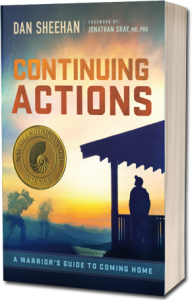Continuing Actions Chapter 4
SOCIETY’S ROLE
“. . . I cannot escape the suspicion that what we do as mental health professionals is not as good as the healing that in other cultures has been rooted in the native soil of the returning soldier’s community.” —Jonathan Shay, Achilles in Vietnam, p.194
SOME SOCIETIES THROUGHOUT history had specific ways of helping their warriors heal the inner chasms created by combat trauma. They had rites of passage, rituals, and meaningful ceremonies designed to welcome the returning warrior, cleanse him of the caustic emotions of battle, and reassure him of his honored position within society.
In his book, No More Heroes, Richard Gabriel explains the societal support for returning warriors that was commonplace among many, if not all, traditional warrior societies:
“Societies have always recognized that war changes men, that they are not the same after they return. That is why primitive societies often required sol- diers to perform purification rites before allowing them to rejoin their communities. These rites often involved washing or other forms of ceremonial cleansing. Psychologically, these rituals provided soldiers with a way of ridding themselves of stress and the terrible guilt that always accompanies the sane after war. It was also a way of treating guilt by providing a mechanism through which fight- ing men could decompress and relive their terror without feeling weak or exposed. Finally, it was a way of telling the soldier that what he did was right and that the community for which he fought was grateful and that, above all, his community of sane and normal men welcomed him back.” (Gabriel, p.155)
In contrast, the following passage from James Wright—historian, author, and Marine—highlights the general relationship between American society and returning veterans:
“Combat veterans then return home. They must suppress their combat experiences in order to return successfully to civil society. But even if they are successfully suppressed, they cannot be forgotten. Each of these tasks of learning and unlearning comes at some cost, and the cost is an intensely personal one that is not borne by society,” (Wright, p.16).
Instead of societal support and ritualistic cleansing of guilt, terror, and stress, our veterans have historically been told to just suppress it all and move on. This lack of understanding on the part of society doesn’t just ignore the problem of veterans’ reintegration, it actively exacerbates it. Instead of facilitating their return, our society unintentionally places additional burdens on returning warriors.
One of these burdens is the sense of isolation many veterans feel after returning home. They’ve been fundamentally changed by their experiences, even if they don’t know how or why, and no longer feel like they fit in. After leaving active duty, veterans in towns and cities across the nation often withdraw from meaningful social interactions with nonveterans to protect themselves from this uncomfortable realization. This response is reinforced by the way our society holds veterans at arm’s length—content to idealize but not understand them.
“Too often, this view of the veteran as a man apart is shared by civilians, who are content to idealize or disparage his military service while avoiding detailed knowledge of what that service entailed. Social support for the telling of war stories, to the extent that it exists at all, is usually segregated among combat veterans. . . . Thus the fixation of the trauma—the sense of a moment frozen in time—may be perpetuated by social customs that foster the segregation of warriors from the rest of society.” (Herman, p.67)
Our society’s negative impact on veterans’ reintegration is not intentional—I don’t think for a minute the American population is unsupportive or insensitive to the issues facing our military. But unreasonable expectations of how veterans “should” be able to return home, and social isolation that denies veterans critical support when they need it most, are real obstacles that derail many veterans’ efforts to move on after their service.
This lack of understanding likely stems from the fact that, thankfully, only a small percentage of Americans have ever experienced combat firsthand. This hasn’t always been the case but it certainly is now. In the last forty-five years, the percentage of veterans decreased from almost half of the population to less than 7%. In 1969, 45% of the adult male population were veterans. And now, in 2014, there are a little under 22 million American veterans out of a population of 318 million—about 6.8%.
And those are just percentages of the population who’ve worn a uniform—the percentages who’ve actually engaged in combat are much smaller. There is no reason to expect a society as sheltered from the reality of combat as ours to understand the profound impact it can have on those it sends to fight.
WHAT DOES IT MATTER?
Why should the general population’s unfamiliarity with the realities of combat have any impact on returning veterans? Because a society without intimate knowledge of the warrior’s outer and inner battles cannot provide the support and guidance traditional societies have used to help their warriors reintegrate after war.
Tom Holm’s book, Strong Hearts, Wounded Souls, brings this concept to light. A Vietnam veteran himself, Holm describes the effects of Native American tribal ceremonies on veterans returning from Vietnam. While the tribes were different, and the ceremonies differed in the details, the rituals and ceremonies were similar in that they were community-based efforts to welcome the warrior home, cleanse him of what he’d had to do in the war, and reintegrate him into the tribe. While the experiences of war were considered impurities that must be cleansed from his soul, the warrior himself was never blamed for those stains. They were simply there and needed to be expunged.
There was an understanding extended to the veteran, an acknowledgement that he had been transformed by his experiences and was now returning to the tribe as a different person. This transformation was assumed—there was no obligation for a veteran to demonstrate that he’d suffered “enough,” experienced “enough” trauma, or been through “enough” hardship to rate feeling different. He went. He did. And he was. That was all the tribe needed to know.
“. . . the Vietnam veterans’ combat experiences gave them a degree of knowledge about a subject few others are even conversant with; and because they are so knowledgeable, they obtain a certain degree of wisdom and respect. . . . A Winnebago elder . . . stated it best. . . . “We honor our veterans for their bravery and because by seeing death on the battlefield they truly know the greatness of life.” “(Holm, p.192)
But the veteran couldn’t just come waltzing back into the tribe and pick up like nothing had happened. Holm describes the reasoning behind cleansing a returning warrior in the Cherokee tradition:
“The Cherokee’s personal bravery and service were cheered, but the war itself, simply because it was a war, was considered a particularly vile human activity. Since it was a vile experience and he was a relative, he had to be relieved of the terrible spell the war had placed upon him. Otherwise, the entire community could become tainted. Distributing the burden of his trauma thus became a community project.” (Holm, p.193)
Far from being a “cure all” or magic ceremony to wipe away the effects of war, the tribal ceremonies were built around the concept that the warrior would never leave the trauma behind and would continually have to deal with it throughout his life. Holm uses a quote from Native American psychologists Don Johnson and Robin LaDue to explain how Native American medicine approaches recovery from trauma:
“It must be clearly understood, acknowledged and accepted that many of the healing ceremonies are not cures, but simply a part of the healing process provided through the entire community. The trauma is a point on the circle of life that must be passed through over and over again . . . It is recognized that each time one returns to the trauma point on the medicine circle there will be some deflection of the path. Here we depend upon the effects of past healing and repetition of appropriate ceremonial healing.” (Holm, p.196)
These tribal traditions didn’t spring up overnight. They weren’t dreamt up in response to some newly perceived trauma associated with modern warfare. These rituals and ceremonies have been an integral part of tribal culture, handed down through the ages by men and women who understood their importance— and the repercussions of ignoring them. They reflect a deep societal understanding of the traumas experienced in war and offer the returning warriors relief without implying that they are weak for needing it.
But unless he or she belongs to a homogeneous society with established rites and rituals for guiding them home from battle, the modern warrior must navigate these treacherous waters alone. This is not to say our veterans are not given societal support, but rather that the support they receive has a different focus.
WHAT ABOUT THE SUPPORT WE DO HAVE?
The GI Bill, employment assistance, disability payments, and other federal benefits are available to most American veterans. The widespread societal support these programs enjoy acknowledges the sacrifices made by our service members and shows our nation’s honest desire to provide real assistance upon their return. Where these programs fall short, however, is in focusing solely on the tangibles. Economic concerns are elevated to supreme importance among the list of challenges returning warriors face. It is as if gaining an education, learning a new skill, or getting a monthly disability check is all a warrior needs to make him whole, healthy, and stable.
While a good start, the benefits offered to our veterans are not comprehensive enough to address all of their needs. Missing are the means to reunite the conscious and unconscious minds and heal the disconnect between who the warrior was and who the warrior is. The veteran can learn skills and earn money, but if he or she is not at peace with their experiences, they will not be healthy and whole. They will not have come home.
This is not an indictment of the VA. That organization is working harder than ever to fulfill the nation’s obligation to her veterans. But the VA cannot do it alone. Health care and economic support? Yes, it can provide those almost totally by itself. But guidance for addressing the full spectrum of war’s impact? No, that will require a team effort by the individual veteran, various nonprofits, and the VA to be successful. Simply put, veterans must play a more active role in their own return than they have been told to expect. We must be the driving force behind our successful return and cannot outsource responsibility for overcoming our challenges to the VA.
Without established rituals and ceremonies that can help us close the chasm between our conscious and unconscious minds, the positive support our society can provide us is limited. There is definite value to the tangible support it does offer, but that support cannot go far enough. This isn’t a fatal flaw in our system, but it does require us to compensate in ways we haven’t been prepared for. It requires us to apply significant effort to understanding our experiences and reactions, get our own houses in order, and then, when our foundations are rock-solid again, make good use of the benefits our society does offer.
We have to marry the two concepts of societal support— inner and outer, spiritual and tangible. You’re going to have to take care of the spiritual yourself.
Then, go claim the tangible.



